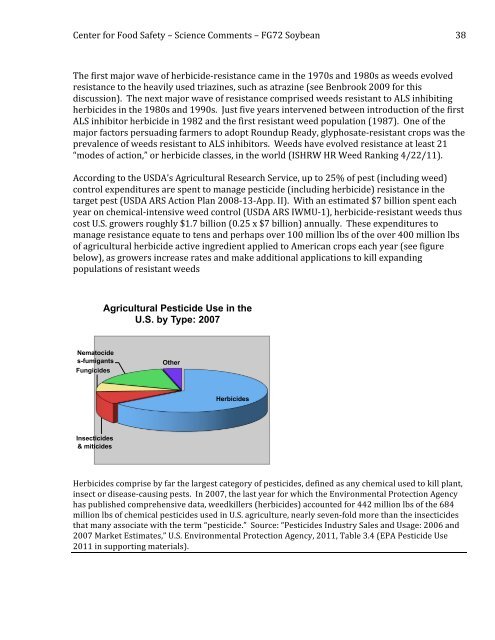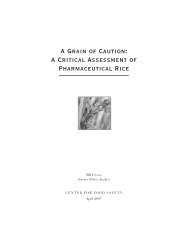a four-fold rise - Center for Food Safety
a four-fold rise - Center for Food Safety
a four-fold rise - Center for Food Safety
You also want an ePaper? Increase the reach of your titles
YUMPU automatically turns print PDFs into web optimized ePapers that Google loves.
<strong>Center</strong> <strong>for</strong> <strong>Food</strong> <strong>Safety</strong> – Science Comments – FG72 Soybean <br />
38 <br />
The first major wave of herbicide-‐resistance came in the 1970s and 1980s as weeds evolved <br />
resistance to the heavily used triazines, such as atrazine (see Benbrook 2009 <strong>for</strong> this <br />
discussion). The next major wave of resistance comp<strong>rise</strong>d weeds resistant to ALS inhibiting <br />
herbicides in the 1980s and 1990s. Just five years intervened between introduction of the first <br />
ALS inhibitor herbicide in 1982 and the first resistant weed population (1987). One of the <br />
major factors persuading farmers to adopt Roundup Ready, glyphosate-‐resistant crops was the <br />
prevalence of weeds resistant to ALS inhibitors. Weeds have evolved resistance at least 21 <br />
“modes of action,” or herbicide classes, in the world (ISHRW HR Weed Ranking 4/22/11). <br />
According to the USDA’s Agricultural Research Service, up to 25% of pest (including weed) <br />
control expenditures are spent to manage pesticide (including herbicide) resistance in the <br />
target pest (USDA ARS Action Plan 2008-‐13-‐App. II). With an estimated $7 billion spent each <br />
year on chemical-‐intensive weed control (USDA ARS IWMU-‐1), herbicide-‐resistant weeds thus <br />
cost U.S. growers roughly $1.7 billion (0.25 x $7 billion) annually. These expenditures to <br />
manage resistance equate to tens and perhaps over 100 million lbs of the over 400 million lbs <br />
of agricultural herbicide active ingredient applied to American crops each year (see figure <br />
below), as growers increase rates and make additional applications to kill expanding <br />
populations of resistant weeds <br />
Agricultural Pesticide Use in the<br />
U.S. by Type: 2007<br />
Nematocide<br />
s-fumigants<br />
Fungicides<br />
Other<br />
Herbicides<br />
Insecticides<br />
& miticides<br />
Herbicides comp<strong>rise</strong> by far the largest category of pesticides, defined as any chemical used to kill plant, <br />
insect or disease-‐causing pests. In 2007, the last year <strong>for</strong> which the Environmental Protection Agency <br />
has published comprehensive data, weedkillers (herbicides) accounted <strong>for</strong> 442 million lbs of the 684 <br />
million lbs of chemical pesticides used in U.S. agriculture, nearly seven-‐<strong>fold</strong> more than the insecticides <br />
that many associate with the term “pesticide.” Source: “Pesticides Industry Sales and Usage: 2006 and <br />
2007 Market Estimates,” U.S. Environmental Protection Agency, 2011, Table 3.4 (EPA Pesticide Use <br />
2011 in supporting materials).







